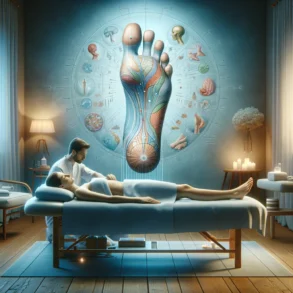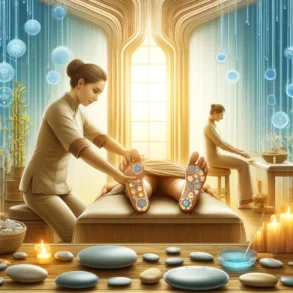Acupressure and Reflexology
Embrace the ancient practices of Acupressure and Reflexology with “Traditional Techniques for Modern Healing.” This insightful article unravels the hidden benefits and fantastic healing power offered by these age-old methods. Enrich your understanding as you uncover how these traditional techniques apply and thrive in the contemporary health and wellness culture. Prepare yourself for a profound journey into holistic healing and health enhancement, made possible by these time-tested paradigms.

Understanding Acupressure and Reflexology
Regardless of whether you’re exploring alternative healing methods or just have a curiosity for traditional eastern techniques, understanding acupressure and reflexology can be a fascinating journey. Both of these modalities rely on the principles of energy flow through the body, although they diverge in terms of their specific practices.
Definition of Acupressure
Acupressure is a 5000-year-old healing method that comes from traditional Chinese medicine (TCM). As its name suggests, it involves applying pressure to specific points on the body known as ‘acupoints’. The aim is to stimulate these points to enhance the flow of vital energy or ‘Qi’ (pronounced as ‘chee’) and restore the body’s balance.
Definition of Reflexology
Reflexology, on the other hand, is a practice that involves applying pressure to specific ‘reflex’ areas—mainly the hands, feet, and ears—that correspond to various organs and systems throughout your body. It works on the principle that these reflex areas are connected to these organs through a system of ‘energy pathways,’ and stimulating them can contribute to better health and wellness.
Brief history of Acupressure and Reflexology
Both acupressure and reflexology have ancient origins. Acupressure developed in China and is a crucial component of TCM. Its historical roots can be traced back thousands of years to the early belief in the vital life force or Qi. Reflexology is believed to have developed in ancient Egypt as seen from the inscriptions on the tomb of a physician named Ankmahor dating back to 2330 B.C. Also, there’s evidence that reflexology was practiced in ancient India and among Native American tribes.
Differences and Similarities between Acupressure and Reflexology
While both acupressure and reflexology use pressure application for healing, they differ in their application areas and theories. In acupressure, the whole body is the canvas with numerous acupoints. However, in reflexology, the focus is mainly on hands, feet, and ears. Yet their underlying philosophy is similar; both believe in the flow of energy in the body which, when unblocked and balanced, fosters better health.
The Principles of Acupressure
To fully appreciate this healing technique, it’s worth delving into the bedrock of its foundational principles.
The Concept of Qi or Life Energy
In acupressure, Qi is seen as the vital force or energy that sustains life. It’s believed that any form of illness or malaise is a result of a blockage or imbalance in the flow of Qi. Acupressure aims to rectify this by manipulating acupoints to free up and rebalance this energy.
Meridians and Pressure Points in Acupressure
Acupoints are located on invisible pathways known as the meridians. These are where the Qi flows. Each meridian corresponds to an organ or a bodily function, and it’s believed that the manipulation of these acupoints affects the respective organ or function.
Yin and Yang Principle in Acupressure
Yin and Yang, the two opposing yet complementary forces in the universe, play an integral role in acupressure. A harmonious balance between the two within the body promotes health and well-being, while imbalance leads to sickness. Acupressure aims to restore this balance.
The Principles of Reflexology
Just as acupressure has its unique principles, so too does reflexology. Understanding these can help illuminate the logic behind the practice.
Understanding the Reflex Zones in the Hands and Feet
Reflexology maps the body onto the hands and feet. Pressure is applied to the corresponding ‘reflex zones’ to influence the function and well-being of various organs and structures.
The Role of the Nervous System in Reflexology
In reflexology, it’s believed that stimulating the reflex zones sends signals along the nervous system, specifically the peripheral nerves, to the relevant body part, thereby promoting healing and wellness.
How Does Reflexology Work?
While the exact mechanism underlying reflexology isn’t completely understood, it’s thought to help relax the nervous system, improve circulation, and promote balancing of the body’s different systems.
How Acupressure Heals
The art of acupressure has profound effects on the body, contributing significantly to healing and wellness.
The Effects of Pressure Application on the Body’s Functioning
Applying pressure to acupoints stimulates nerve conduction and blood circulation, while simultaneously relieving muscle tension. This, in turn, helps vital energies travel freely and boosts overall well-being.
Common Ailments and Conditions Treated by Acupressure
Acupressure is used to address various conditions such as headaches, fibromyalgia, menstrual cramps, digestive problems, and more. It’s also beneficial for stress, sleep disorders, and maintaining overall wellness.
Scientific Studies Supporting Acupressure
While the scientific evidence supporting acupressure isn’t as robust as for conventional medicine, some studies suggest it can effectively manage conditions like nausea, pain, and stress. However, further research is needed to validate these findings.

How Reflexology Heals
Operating on different principles, reflexology too offers significant healing benefits.
The Impact of Stimulating Reflex Zones on Health
Stimulating reflex zones helps to balance the body’s systems, improve blood flow, release toxins, and encourage a state of deep relaxation and healing.
Common Health Issues Addressed by Reflexology
Reflexology may help manage a range of conditions, including headaches, digestive issues, stress, PMS symptoms, and chronic pain, among others.
Evidences Backing up Reflexology Benefits
Like acupressure, reflexology lacks an extensive body of scientific evidence. However, some studies do suggest its effectiveness for problems like tension headaches, arthritis pain, and other stress-related disorders.
Practical Acupressure Techniques
As an active practitioner, you would want to grasp a few important techniques and tips when it comes to acupressure.
How to Locate Acupressure Points
Acupressure points or acupoints are located all over the body. While some are easy to find because they’re located at obvious places (like the center of your palm), others require a bit more knowledge and precise measurement.
Ways to Apply Pressure in Acupressure
Different methods are used in acupressure—using fingers, palms, or even special tools to apply varying levels of pressure to acupoints. The technique used often depends on the location of the acupoint and the condition being treated.
Safety Tips for Practicing Acupressure
While acupressure is generally safe, it’s not recommended for certain individuals, such as pregnant women, or on certain areas, like the abdomen or over wounds. Having a basic understanding of anatomy is crucial to avoid causing harm.

Practical Reflexology Techniques
Reflexology involves a skill set that, while easy to grasp, requires careful execution for the ways of stimulating reflex zones safely and efficaciously.
How to Identify Reflex Zones
Reflex zones in reflexology are mainly found in the hands, feet, and ears, each corresponding to a different part of the body. One needs to understand the reflexology chart well to be able to identify these zones accurately.
Methods to Stimulate Reflex Areas
Techniques employed in reflexology range from finger and thumb walking to slide and press. All of these aim at stimulating the reflex zones optimally.
Safety Guidelines for Performing Reflexology
Though reflexology is a non-invasive therapy, it still requires adherence to certain safety measures — such as not pressing too hard, or avoiding certain areas for pregnant women, or for individuals with certain health conditions.
The Effectiveness of Acupressure and Reflexology
The efficacy of these modalities is still a topic of debate. As with many alternative therapies, the scientific community and general public have contrasting views.
Arguments for and against the Efficacy of These Therapies
While many testify to their positive experiences with acupressure and reflexology, skeptics argue that these effects are due more to the placebo effect than the techniques themselves. That said, neither the testimonials nor the criticisms can be easily dismissed.
Comparative Studies of Acupressure and Reflexology
A few studies comparing these therapies have been conducted. While some have found similarities, most have found significant differences in effectiveness, depending on the condition under question.
The Place of Acupressure and Reflexology in Modern Medicine
The holistic outlook of these therapies, focusing on the overall well-being rather than merely addressing symptoms, has earned them a significant place in modern integrative healthcare practices. Many modern practitioners are open to using them as complementary approaches to conventional medicine.

Training and Professional Practice in Acupressure and Reflexology
For those interested in becoming practitioners, these modalities require specialized training and qualifications.
Qualifications Required to Practice Acupressure and Reflexology Professionally
To practice professionally, one needs specialized training in acupressure or reflexology or both. A certification program typically involves comprehensive coursework and a certain number of hands-on hours.
An Overview of Acupressure and Reflexology Training Programs
Training programs offer a deep dive into the principles, techniques, and practical applications of these therapies. They typically cover anatomy, physiology, professional ethics, and business practices.
Certifications and Professional Associations in Field
Certifications enable practitioners to showcase their knowledge, skills, and commitment to the practice. Professional associations, on the other hand, offer a platform to connect, learn, and grow with other professionals in the field.
Acupressure and Reflexology in Everyday Life
While professional practitioners can offer specialized care, these therapies can also find a place in everyday self-care routines.
The Role of Acupressure and Reflexology in Self-care
With some basic training, these techniques can be used to manage stress, relieve minor ailments or pain, or just promote general well-being.
Integrating These Therapies into Your Health Routine
By becoming aware of certain key points or zones in acupressure and reflexology respectively, you can incorporate these practices into your day-to-day health regimen. From easing a headache to fostering better sleep, these techniques are very versatile.
Finding an Acupressure or Reflexology Practitioner
Numerous listings and platforms can aid you in finding a qualified professional in your area. Always look for practitioners with recognized qualifications and positive client testimonials.
Looking at acupressure and reflexology, they teach us a lot about the potential of our own bodies to foster health and wellness. Whether you choose to explore them as a client, a self-care enthusiast, or someone who wants to take up a professional practice, understanding these therapies offers a unique pathway to a more holistic and healthy lifestyle.
Acupressure and Reflexology
For those interested in learning about acupressure and reflexology, here are three comprehensive resources:
- Acupressure.com offers a wide range of acupressure online training and courses, including certification programs taught by Michael Reed Gach, Ph.D. These courses are designed to provide a deep understanding of acupressure for both personal and professional growth, covering topics like stress relief, immune boosting, and self-care for common ailments. The site also includes digital acupressure chart sets, instructional videos, and more for learners at all levels (Acupressure).
Visit: https://acupressure.com
- Modern Reflexology provides detailed information on acupressure points to improve overall health. The site covers the benefits of acupressure, how it works, and specific acupressure points for treating conditions like headaches, local pain, flu, allergies, and more. It’s a valuable resource for those looking to learn about acupressure’s role in Chinese medicine and how to apply pressure to certain body points for health benefits (Modern Reflexology).
- Best Life Acupressure & Reflexology specializes in the traditional form of acupressure practiced in Asia for over 3,000 years. Their professional team uses key points on the skin to stimulate the body’s natural healing abilities, helping to relieve muscle tension and promote blood circulation. The site provides information about their services, including acupressure and reflexology treatments, appointment booking, and contact details (Best Life Acupressure).
These resources offer a mix of educational content, professional services, and self-help techniques for those interested in exploring the benefits of acupressure and reflexology.
